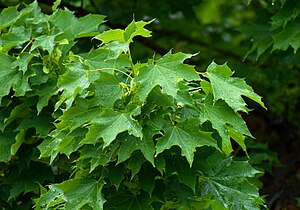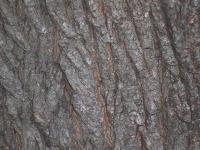Acer platanoides
| Nowray Maple | |
|---|---|
 | |
| Binomial: | Acer platanoides |
| Family: | Sapindaceae |
| Type: | Tree |
Acer platanoides (Norway Maple) is a species of maple native to eastern and central Europe and southwest Asia, from France east to Russia, north to southern Scandinavia and southeast to northern Iran.[1][2] It is widely cultivated elsewhere, and is also an invasive in some areas.[3]
Description
[edit | edit source]It is a deciduous tree growing to 20–30 m tall with a trunk up to 1.5 m diameter, and a broad, rounded crown. The bark is grey-brown and shallowly grooved; unlike many other maples, mature trees do not tend to develop a shaggy bark. The shoots are green at first, soon becoming pale brown; the winter buds are shiny red-brown. The leaves are opposite, palmately lobed with five lobes, 7–14 cm long and 8–20 cm (rarely 25 cm) across; the lobes each bear one to three side teeth, and an otherwise smooth margin. The leaf petiole is 8–20 cm long, and secretes a milky juice when broken. The autumn colour is usually yellow, occasionally orange-red. The flowers are in corymbs of 15–30 together, yellow to yellow-green with five sepals and five petals 3–4 mm long; flowering occurs in early spring before the new leaves emerge. The fruit is a double samara with two winged seeds, the seeds are disc-shaped, strongly flattened, 10–15 mm across and 3 mm thick. The wings are 3–5 cm long, widely spread, approaching a 180° angle. It typically produces a large quantity of viable seeds. It is not particularly long-lived, with a maximum age of around 250 years.[4][5][6][7]

Norway Maple is a member (and is the type species) of the section Platanoidea Pax, characterised by flattened, disc-shaped seeds and the shoots and leaves containing milky sap. Other related species in this section incluse Acer campestre (Field Maple), Acer cappadocicum (Cappadocian Maple), Acer lobelii (Lobel's Maple), and Acer truncatum (Shandong Maple). From Field Maple, Norway Maple is distinguished by its larger leaves with pointed, not blunt, lobes, and from the other species by the presence of one or more teeth on all of the lobes.[4][5]
It is also frequently confused with the more distantly related Acer saccharum (Sugar Maple). Sugar Maple is easy to distinguish from this species by the clear sap in the petiole (Norway Maple has white sap in the petiole). The tips of the points on Norway Maple leaves reduce to a fine "hair", while the tips of the points on Sugar Maple leaves are on close inspection rounded. On mature trees, Sugar Maple bark is more shaggy, while Norway Maple bark has small, often criss-crossing grooves. While the shape and angle of leaf lobes vary somewhat within all Maple species, the leaf lobes of Norway Maple tend to have a more triangular shape, in contrast to the more squarish lobes often seen on Sugar Maples. The seeds of Sugar Maple are globose, while Norway Maple seeds are flattened. Sugar Maple usually has a brighter orange autumn colour.[4][5]
Growing Conditions
[edit | edit source]Varieties
[edit | edit source]Many cultivars have been selected, with distinctive leaf shape or coloration such as the dark purple of 'Crimson King' and 'Schwedleri', the variegated leaves of 'Drummondii' and 'Emerald Queen', and the deeply divided, feathery leaves of 'Dissectum' and 'Lorbergii'. The purple-foliage cultivars have orange to red autumn colour. 'Columnare' is selected for its narrow upright growth.[5][8]
Uses
[edit | edit source]
The wood is hard, yellowish-white to pale reddish, with the heartwood not distinct; it is used for furniture and turnery.[9]
It has been widely introduced into cultivation in other areas, including western Europe northwest of its native range. It grows north of the Arctic Circle at Tromsø, Norway. In North America, it is grown as a street and shade tree. It is favoured due to its tolerance of poor, compacted soils and urban pollution. As a result of these characteristics, Norway Maple is displacing locally native hardwoods in some parts of North America and is considered invasive in some states,[3] but is still widely used for urban plantings in many areas. Norway Maple itself is threatened in a few areas by the Asian long-horned beetle, which eats through the trunk of trees, often killing them.
-
A mature tree in Belgium
-
Tree in flower
-
Flower, close-up
-
Foliage
Maintenance
[edit | edit source]Bad crotching can be an issue, and since the wood is relatively weak the tree can easily split in windstorms.
Propagation
[edit | edit source]Cultivars are propagated by cutting or grafting, otherwise the tree produces abundant fertile seed.
Pests and Diseases
[edit | edit source]Norway Maple is generally free of serious diseases, though can be attacked by the powdery mildew Uncinula bicornis, and verticillium wilt disease caused by Verticillium spp.[10]
References
[edit | edit source]- ↑ Flora Europaea: Acer platanoides distribution
- ↑ Den virtuella floran: Acer platanoides distribution
- ↑ a b Swearingen, J., Reshetiloff, K., Slattery, B., & Zwicker, S. (2002). "Norway Maple". Plant Invaders of Mid-Atlantic Natural Areas. National Park Service and U.S. Fish & Wildlife Service.
{{cite web}}: CS1 maint: multiple names: authors list (link) - ↑ a b c Rushforth, K. (1999). Trees of Britain and Europe. Collins ISBN 0-00-220013-9.
- ↑ a b c d Mitchell, A. F. (1974). A Field Guide to the Trees of Britain and Northern Europe. Collins ISBN 0-00-212035-6
- ↑ Mitchell, A. F. (1982). The Trees of Britain and Northern Europe. Collins ISBN 0-00-219037-0
- ↑ Norwegian Botanical Association: Acer platanoides photos
- ↑ Huxley, A., ed. (1992). New RHS Dictionary of Gardening. Macmillan ISBN 0-333-47494-5.
- ↑ Vedel, H., & Lange, J. (1960). Trees and Bushes in Wood and Hedgerow. Metheun & Co. Ltd., London.
- ↑ Phillips, D. H., & Burdekin, D. A. (1992). Diseases of Forest and Ornamental Trees. Macmillan ISBN 0-333-49493-8.
- Book:Horticulture/Finder/Types/Trees, Large
- Book:Horticulture/Finder/Seasons/Spring
- Book:Horticulture/Finder/Conditions/Full Shade
- Book:Horticulture/Finder/Conditions/Part Shade
- Book:Horticulture/Finder/Conditions/Full Sun
- Book:Horticulture/Finder/Conditions/Drought Tolerant
- Book:Horticulture/Finder/Resistance/Pests and Diseases
- Book:Horticulture/Finder/Resistance/Deer
- Book:Horticulture/Finder/Invasive/North America
- Book:Horticulture/Finder/Native/Europe
- Book:Horticulture/Finder/Flowers/Green



